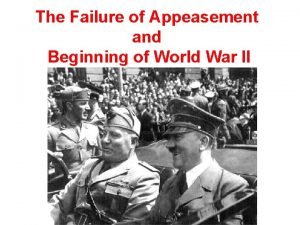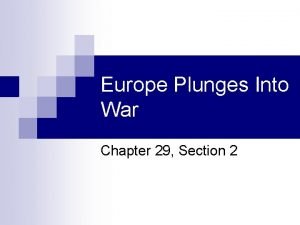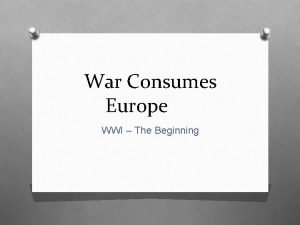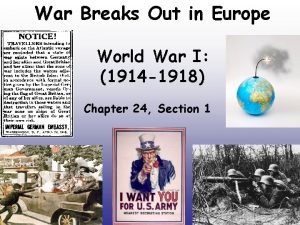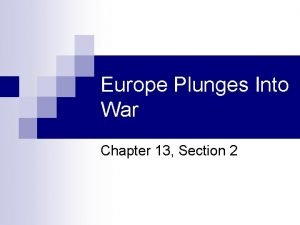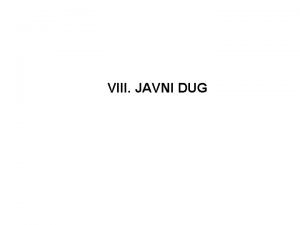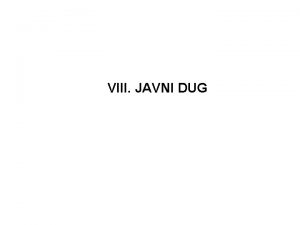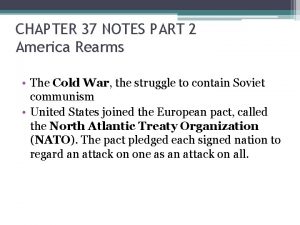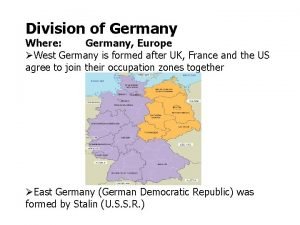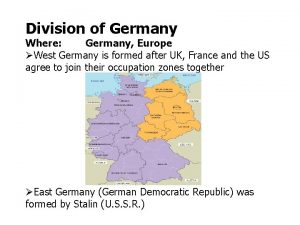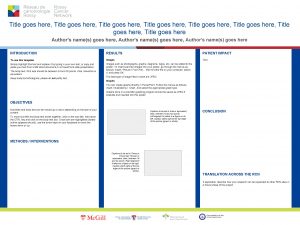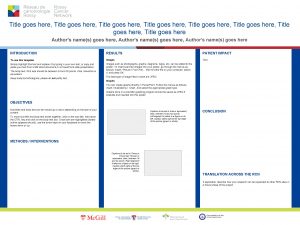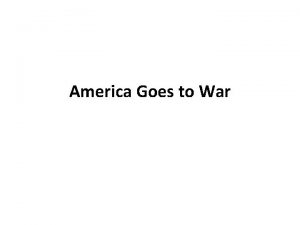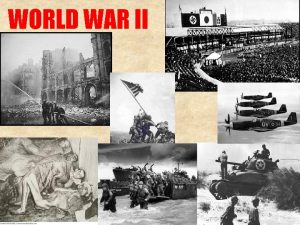Europe Goes to War Germany Rearms Germany dug


















- Slides: 18

Europe Goes to War

Germany Rearms �Germany dug itself out of depression by rearming and expanding their armed forces (both of which violated the Versailles Treaty that ended WWI) �Unemployment fell to zero, Germany boomed and was ready to put Hitler’s expansion plans to work

Germany Invades the Rhineland � � The German military entered the Rhineland (an area in Western Germany they were supposed to be banned from) Great Britain and France had not forgotten about the large cost of WWI and did not do anything to stop the Germans 1936 - Hitler and Mussolini sign an alliance and create Axis powers (Later joined by Japan) Axis powers (Germany, Italy, Japan)

Germany Expands � Germany occupied Austria in 1938 takes the Sudetenland (an industrial region of Czechoslovakia) in 1938 � British Prime Minister Neville Chamberlin and French President Edouard Daladier offered Hitler a policy of appeasement (giving in to a competitor’s demands in order to keep the peace) at the Munich Conference in 1938 � They thought that giving Hitler the Sudetenland would stop his conquest of Europe � Hitler promised the Sudetenland was all he wanted but six months later he invaded the rest of the country and divided it up among his allies

End of Appeasement � After Hitler invaded Czechoslovakia, France and Great Britain prepared for war, knowing Hitler did not plan on ending his conquest for more territory � France and GB pledged their support for Poland if Germany invaded them

Hitler and Stalin Align �Not wanting to fight a two front war, Hitler agreed to a ten year non- agression pact with the Soviet Union �A secret document of the Pact divided up the independent Eastern European countries between Germany and the USSR �USSR and Germany hated each other but had much to gain by not fighting one another

Invasion of Poland �On September 1, 1939 Germany invaded Poland �On September 3, 1939 Great Britain and France declared war on Nazi Germany

Invasion of Poland

The Blitzkrieg � While invading Poland the Germans used their new method of attack known as the Blitzkrieg (Lightning War) • Fast, concentrated air and land attack that took the enemy’s army by surprise � German army was more prepared and had better weapons than the Polish, French, and British Armies � Poland was under German control in less than a month � Imposed German laws and persecuted Polish Jews

Maginot Line �Fortified line of defense built by the French protecting them from the Germans along the German border �Weaknesses: Guns only faced Germany, wall did not protect against Belgium

Germany Attacks � On April 9, 1940 Germany launched a blitzkrieg against the Netherlands, Belgium, and Luxembourg and controlled all of them within 3 weeks � Germany then invaded France through Belgium so they avoided the Maginot Line

Invasion of France

Dunkirk (Dunkerque) � German forces split the French and British forces in half and trapped many troops in the northern town of Dunkirk, France � Facing heavy artillery from the Luftwaffe (German Air Force), 340, 000 troops escaped capture by boarding 900 naval vessels and fleeing to GB

Fall of France �After Dunkirk, Germany moved south to Paris which was abandoned by the Government �On June 22 the French surrendered to Germany

The Resistance �General Charles de Gaulle led the Free France revolution against Germany �Free France would sabotage German operations in France and distribute anti German leaflets

Battle of Britain � After the Fall of France, Hitler planned his next invasion: Great Britain � In August 1940 the Luftwaffe unleashed the greatest air attack ever seen upon GB � Day after day as many as 1, 000 planes rained bombs on Britain

Taking the War to Civilians � At first the Luftwaffe bombed aircraft factories, oil storage tanks, ports, radio installations, and airfields � In late August German planes started to bomb London and civilians � The bombing of London would target civilian population centers to break their will to resist and would continue until May 1941 � Both sides targeted civilians and caused a total war

Defense of Great Britain �Britain's Royal Air Force (RAF), greatly outnumbered, defended its homeland against the Luftwaffe �By the end of the air raids 20, 000 people in London were killed and 70, 000 injured
 Jk annand mince and tatties
Jk annand mince and tatties In your notebook write how often dug does these activities
In your notebook write how often dug does these activities If the books have been cataloged
If the books have been cataloged Types of latrines
Types of latrines Javni dug srbije statistika
Javni dug srbije statistika Remains by simon armitage annotated
Remains by simon armitage annotated Javni dug srbije po godinama
Javni dug srbije po godinama Pravo i finansije
Pravo i finansije Vanjski dug bih
Vanjski dug bih Prepricana lektira nosac samuel
Prepricana lektira nosac samuel Pfil collins
Pfil collins Dug srbije po godinama
Dug srbije po godinama Javni dug srbije
Javni dug srbije Appeasement definition ww2
Appeasement definition ww2 Europe plunges into war chapter 29 section 2
Europe plunges into war chapter 29 section 2 War consumes europe
War consumes europe War breaks out in europe
War breaks out in europe The war in europe ww2
The war in europe ww2 Europe plunges into war
Europe plunges into war













